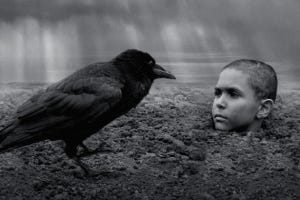The Painted Bird

I was initially excited to watch and review Czech writer/director Václav Marhoul’s adaptation of Jerzy Kosinski’s novel “The Painted Bird,” which will be available on VOD as of Friday, July 17. I knew it was almost three hours long (2 hours 49 minutes, specifically). I knew it was shot in black and white. I knew it was subtitled. I knew it was about the Holocaust. I knew it sported an impressive cast of character actors including Stellan Skarsgård, Harvey Keitel, Udo Kier, Julian Sands (“Warlock” represent!) and Barry Pepper.
Then I started reading a bit more and grew trepidatious. Comparisons were being made between “The Painted Bird” and “Salò, or the 120 Days of Sodom,” “Come and See” and “A Serbian Film” … movies I’ve been too chickenshit to watch as of now. I was legit scared, y’all! Turns out I had reason to be, but that’s not an entirely bad thing.
“The Painted Bird” is simultaneously one of the most disturbing and beautiful films I’ve ever seen. This is less a story and more a series of vignettes about a young Jewish boy (Petr Kotlár) in Eastern Europe during World War II seeking refuge from an onslaught of different characters. The boy is the recipient of all sorts physical and sexual abuse. We’re introduced to the boy as he’s fleeing from bullies with his pet ermine tucked beneath his arm. The boy’s tormentors ultimately catch up to him, beat him, snatch the snoat, pour an accelerant all over it and set the poor thing ablaze.
This is just the tip of the iceberg. Fair warning – these descriptors get graphic. Over the course of “The Painted Bird” audiences will see the boy buried up to his neck and pecked by crows, one man gouges another man’s eyes out with a spoon, one woman shoves a glass bottle in another woman’s vagina and kicks it instantly killing her, a crying baby and its mother are executed via gunshot, a woman is depicted engaging in bestiality with a goat.
Despite all the abominations on screen, “The Painted Bird” is undeniably exquisite. This is easily the best-looking movie I’ve seen this year that’s not Terrence Malick’s “A Hidden Life.” The black and white cinematography by Vladimír Smutný (“Kolya”) provides audiences with a cornucopia of striking contrast shots. The way in which Marhoul and Smutný shoot fields, streams, trees and buildings is truly awe-inspiring. Any frame of the film – even some depicting depravities – could easily be blown up, framed and displayed in a museum.
Marhoul makes numerous interesting artistic, stylistic and thematic decisions. This is the first film to use Interslavic language. Marhoul did this so no particular countries would be held accountable for the contemptible actions of his characters. There is no score used until the final scene. The boy’s name isn’t revealed until the final scene.
Marhoul worked on “The Painted Bird” for over a decade and shot over the course of 16 months, which gives audiences the opportunity to see the boy/ Kotlár grow before our very eyes. This is Kotlár’s acting debut and he does good work, although the boy’s a bit of a cypher and doesn’t speak much. The kid’s certainly photogenic and his big, dark eyes communicate much. Of the bigger name actors I was most impressed by Keitel, who brings much needed warmth to the proceedings, and Pepper – essentially playing a Russian variation on his “Saving Private Ryan” character.
“The Painted Bird” won 10 prizes at the Czech Lion Awards on 13 nominations … it also caused walkouts at the Venice, Toronto and London film festivals. I can wholeheartedly understand both reactions. This is pretty much solely for adventurous filmgoers who aren’t squeamish. I’m very glad I saw it once. I wish I’d seen it on the big screen. I’ll likely never watch it again. I think it’s an important film. I think it should be seen by those who think they can withstand it.
“The Painted Bird” derives its name from an early sequence in which Lekh (Lech Dyblic) – a fowler who’s “caring” for the boy – catches a bird, paints it and releases it back into the flock where it’s promptly killed for being different … all for his amusement. This is a somewhat obvious metaphor to the horrors the boy will experience throughout the rest of the film. Marhoul has said “The Painted Bird” isn’t specifically a Holocaust movie … and he’s right. Sadly, this shit’s still pertinent as brown children have been sexually abused and sitting in cages during a pandemic through no fault of their own due to the carelessness and vindictiveness of white men in power right here in the good ole U.S. of A.
[embed]https://www.youtube.com/watch?v=bRDuc3IdOn8[/embed]



